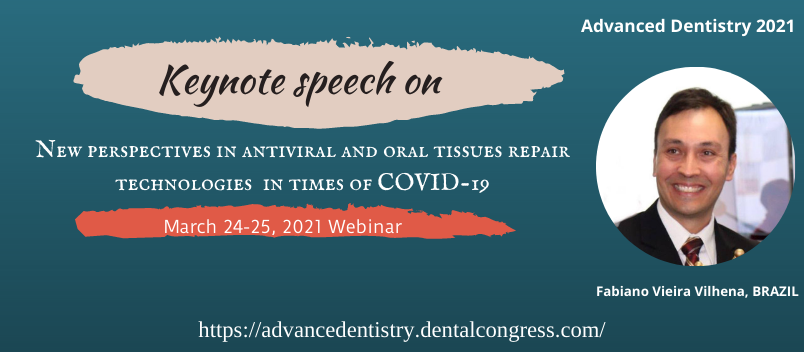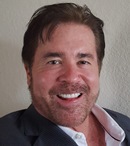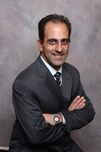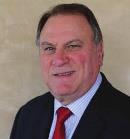Theme: Advanced Dentistry for today’s lifestyle
Advanced Dentistry 2021
Advanced Dentistry 2021:
Conference Series LLC Ltd welcomes all the participants from all over the world to attend the #Webinar on "34th International Conference on Dental Science & Advanced Dentistry” scheduled on March 24-25, 2021. The theme of the esteemed event is "Advanced Dentistry for today’s lifestyle" which will bring together Dentists, Dental professional, Dental Hygienists, Dental Students, Dental researchers, Dental Educators, Dental Business Leaders etc. from all over the world who are engaged in the field of Dentistry.
Conference Series LLC Ltd organizes 3000+ global events in a calendar year which includes International Conferences, Workshops, Exhibitions, and Symposia in all the important disciplines like Clinical, Medical Pharmaceutical, Management, Engineering etc.
What's New?
Advanced Dentistry Conference-2021 includes international attendee workshops, lectures, and exhibitions, poster presentations including a designated registration area, a refreshment break, and gala lunch. Participants can join the Advanced Dentistry Conference 2021 as an international member to receive special benefits on registration packages. So come and join leading experts and eminent professionals to keep up with the pace of modern developing dentistry world will continue to in the future.
Target Audience:
- Dental Surgeons
- Principal Dentist's
- Dental Nurses
- Orthodontists
- Periodontics
- Dentists
- Dental House Officers
- Dental and Oral Health Researchers, Faculty and Students
- Dental and Oral Health Associations, Societies and Universities
- Dental or Oral Hygienists & Therapists
- Dental Treatment Coordinators
- Dental Partners or Owners
- Dental Wholesalers, Dealers and Distributors
- Manufacturing Medical Devices Companies
- Dental Business/Practice Managers
Potential Participants: Advanced Dentistry Conference-2021 welcomes attendees from all universities, dental clinics, dental companies etc. to share their experiences on all aspects of this rapidly expanding stream and thereby, providing a showcase of the latest research and provide a better health care to the world.
Track 1: Dental public health
Good dental or oral care is important to sustaining healthy teeth, gums and tongue. Oral problems comprising bad breath, dry mouth, canker or cold sores, TMD, tooth decay, or thrush are all treatable with proper diagnosis and care. Oral health is necessary to general health and well-being at every stage of life. A healthy mouth enables not only nourishment of the physical body, but also improves social interaction and promotes self-esteem and feelings of well-being.
Track 2: Endodontics
Endodontic is the division of dentistry that deals with infections of the tooth root, dental pulp, and adjacent tissue. Teeth are composed of a rigid structure surrounding a soft, living tissue called the pulp. The pulp comprises nerves, blood vessels and connective soft tissue. When the pulp become diseased or damaged and eventually dies, treatment will be essential to save the tooth. Root canal therapy is the most common technique done by an endodontist to remove the infested pulp and nerves from the tooth’s root canal. Other procedures include endodontic retreatment and endodontic surgery to prevent extractions.
Track 3: Forensic Odontology
Forensic odontology is the proper handling, examination and evaluation of dental evidence, which will be then presented in the interest of justice. The evidence that may be derived from teeth is the age (in children) and identification of the person to whom the teeth belong. This is done using dental records including radiographs, ante-mortem (prior to death) and post-mortem (after death) photographs and DNA. The other type of evidence is that of bite marks, left on either the victim (by the attacker), the perpetrator (from the victim of an attack), or on an object found at the crime scene. Bite marks are often found on children who are abused.
Track 4: Geriatric Dentistry
Geriodontics is the delivery of dental care to older adults involving the diagnosis, prevention, and treatment of problems associated with normal aging and age-related diseases as part of an interdisciplinary team with other health care professionals. The dental diseases that the elderly are particularly prone to are root caries, attrition, periodontal disease, missing teeth because of earlier neglect, edentulism, poor quality of alveolar ridges, ill-fitting dentures, mucosal lesions, oral ulceration, dry mouth (xerostomia), oral cancers, and rampant caries.
Track 5: Oral and Maxillofacial Surgery
Oral & Maxillofacial Surgery is the division of dentistry that comprises surgery to correct diseases, injuries and flaws in the head, neck, face, jaws and the hard and soft tissues of the oral and Cranio-maxillofacial region. The field of Oral & Maxillofacial Surgery varies from simple extractions and surgical removal of buried teeth to controlling of facial trauma. Typical oral surgical processes includes extraction of teeth, wisdom teeth surgery, dental extractions for physically compromised patients, placement of dental implants, bone grafting, tongue tie surgery , and analysis and treatment of cysts and tumors.
Track 6: Oral Implantology
Oral Implantology is intended to promote study and scientific research in the field of dental implantology and allied biomedicaz disciplines at Dental Dubai. It provides valuable information to general dentists, oral surgeons, prosthodontics, periodontists, scientists, clinicians, laboratory owners and technicians, manufacturers, and educators during Dentistry workshop and Dentistry conferences. Dental Implant basics, prosthetics, pharmaceuticals, and the latest research in implantology, implant surgery, and advanced implant procedures.
Track 7: Oral Cancer
Oral cancer can form in any portion of the mouth or throat. Most oral cancers begin in the tongue and in the floor of the mouth. Anybody can get oral cancer, but the threat is higher for male, over age 40, use tobacco or alcohol or have a past of head or neck cancer. Repeated sun exposure is also a risk for lip cancer. Oral cancer treatmentsmay comprise surgery, radiation therapy or chemotherapy.
Track 8: Orthodontics
Orthodontics is the division of dentistry that deals with teeth arrangement to correct malocclusions and also the modification of facial growth. While orthodontic treatment has usually been suggested for functional reasons, it is increasingly used for aesthetic reasons to develop a person’s appearance. Typical problems corrected using orthodontic applications include improperly aligned teeth, crowded or irregularly spaced teeth, swelling teeth, extra or missing teeth, misaligned jaws and bite problems. Orientation problems could also have arisen through accidents , prolonged thumb sucking or pacifier sucking in grown-up children, missing teeth, premature or late loss of baby teeth, tumors in the mouth, dental disease or inadequately fitted fillings, crowns or braces.
Track 9: Pediatric Dentistry
Pediatric dentistry is the dental field that provides primary and widespread oral health care for children from infancy through youth and patients with special health care needs. Pediatric dental treatment and disease avoidance is provided for children up to 14 years of age, with special services for newborns and infants. Pediatric dentists encourage the dental health of children as well as help as educational resources for parents. Early detection is necessary to maintain oral health, modify unusual habits, and treat as needed and as simply as possible.
Track 10: Prosthodontics
Prosthodontics or prosthetic dentistry: is the part of dentistry that focuses on dental prostheses. Prosthodontists offer multi-disciplinary levels of care and offer the most progressive form of sequencing treatment, restorative treatment and maintenance. Prosthodontic treatments are designed to produce a balance between functionality, longevity and aesthetics, which include crowns and bridges, bonding and veneers, dentures, dental implants, and full mouth restoration.
Track 11: Veterinary Dentistry
Veterinary dentistry is the field of dentistry applied to the care of animals. It is the art and science of prevention, diagnosis, and treatment of conditions, diseases, and disorders of the oral cavity, the Maxillo-facial region, and its associated structures as it relates to animals. It is important to examine the whole animal, even when the primary complaint is the mouth. Some dental diseases may be the result of a systemic problem and some may result in systemic complications. In all cases, dental procedures require a general anesthetic so it is important to establish the cardiovascular and respiratory status and canine and feline physiological values of the patient to avoid risks or complications.
Track 12: Cosmetic Dentistry
Cosmetic dentistry states to any dental work that improves the appearance of a person's teeth, gums. It mainly focuses on enhancement dental aesthetics in color, position, shape, size, alignment and overall smile appearance. It involves the addition of a dental material to teeth or gums, removal of tooth structure or gums, straightening of teeth accompanied by an improvement in appearance of face.
Track 13: Restorative Dentistry
Restorative Dentistry is the study, analysis and integrated management of diseases of the oral cavity, the teeth and supporting structures. It comprises the rehabilitation of the teeth and the oral cavity to the functional, psychological and aesthetic necessities of the individual patient, including the coordination of multi-professional working to achieve these objectives. The focus of the Restorative Dentistry specialty is to work with other dental, medical and surgical specialists and other clinical associates, to provide and support the integrated management and oral rehabilitation of patients with complex treatment needs.
Track 14: Periodontics
Periodontics or Periodontology is the division of dentistry that deals with the management of the tissues surrounding and supporting the teeth, especially the gums. Gum cure is essential to prevent tooth loss. Common periodontal processes include scaling and root development, periodontal surgery, dental implants, and cosmetic techniques such as crown lengthening, soft tissue grafts, and ridge augmentation.
Track 15: Oral Appliance therapy
Oral appliance therapy is an effective cure option for snoring and obstructive sleep apnea (OSA). A custom-fit oral sleep appliance can recover sleep, restore alertness and rejuvenate health. Worn only during sleep, an oral appliance fits like a sports mouth guard or an orthodontic retainer. It supports the jaw in a forward point to help retain an open upper airway. Study shows that oral appliance therapy is an effective treatment preference for snoring and obstructive sleep apnea. The therapy is an effective, non-invasive treatment that fits easily into lifestyle.
Track 16: Sleep Apnea Syndrome
There are numerous types of sleep apnea, but the most common is obstructive sleep apnea. It is a potentially severe sleep disorder. It causes breathing to frequently stop and start during sleep. This type of apnea arises when throat muscles intermittently relax and block airway during sleep.
Track 17: 3-D imaging in dentistry
3D Imaging is one of the most significant tools for orthodontists to evaluate and record size and form of craniofacial structures. Orthodontists regularly use 2-dimensional (2D) static imaging procedures, but deepness of structures cannot be acquired and restricted with 2D imaging. Three-dimensional (3D) imaging has been developed in the early of 1990's and has gained a prized place in dentistry, particularly in orthodontics. In 3D diagnostic imaging, a series of anatomical records is gathered using certain technical equipment, processed by a computer and later presented on a 2D monitor to present the illusion of deepness.
Track 18: Orofacial Myofunctional therapy in dental practice
Orofacial Myofunctional Therapy It is neuro-muscular re-education of the oral facial muscles through a chain of exercises, to help in the normalization of the developing or advanced craniofacial structures and function. It is behavioral modification to eradicate dysfunctional practices. It works with the muscles of the lips, tongue, cheeks and face and their related purposes such as breathing, sucking, chewing, swallowing and speech as well as the rest position of the tongue and cheeks. It is used to form, balance, and stabilize, the stomatognathic and cranial systems.
Track 19: Dental Ethics
Ethics is a discipline dealing mainly with moral duty, conduct, and judgment. The dentist and the practice of dentistry are organized by many laws on the federal, state, and local level. Dental Ethics mean moral duties and obligations of the dentist towards his patients, specialists and associates and society. "Dentistry meetings" and Dentistry conferences help to encourage the welfare and equality of human beings.
Track 20: Dental Marketing
Dental market is a swiftly growing section with numerous products at different stages of clinical pipeline and others at different stages of industry life cycle. Disease incidences are escalating rapidly across the globe due to which high unmet demand has been formed and companies along with researchers are trying to provide effective medical care to patients. Dentistry congress, Dentistry workshops and Dentists Meeting delivers the good platform for the dental practice business aspects.
Dentistry is a branch of medicine that is involved in the study, diagnosis, prevention, and treatment of diseases, disorders and conditions of the oral cavity, commonly in the dentition but also the oral mucosa, and of adjacent and related structures and tissues, particularly in the maxillofacial area. Dentistry is often the first line of defense for the oral health and hygiene of a person. Dentistry is important for overall health. Dental treatment is carried out by the dental team, which often consists of a dentist and dental auxiliaries . The majority of dental treatments are carried out to prevent or treat the two most common oral diseases which are dental caries and periodontal disease. Common treatments involve the restoration of teeth, extraction or surgical removal of teeth, scaling and root planing and endodontic root canal treatment.
Dentistry is one of the most rewarding professions to pursue. Through education, diagnosis and treatment, dentists provide the public with an essential health service. Research is continuing to show that the link between oral health and general health is strong.
FUTURE OF DENTISTRY:
Advances in dental research, including genetic engineering, the discovery of links between oral and systemic diseases, the development of salivary diagnostics and the continued development of new materials and techniques, make dentistry an exciting, challenging and rewarding profession.
Conference Highlights
- Dental public health
- Endodontics
- Forensic Odontology
- Geriatric Dentistry
- Oral and Maxillofacial Surgery
- Oral Implantology
- Oral Cancer
- Orthodontics
- Pediatric Dentistry
- Prosthodontics
- Veterinary Dentistry
- Cosmetic Dentistry
- Restorative Dentistry
- Periodontics
- Oral Appliance therapy
- Sleep Apnea Syndrome
- 3-D imaging in dentistry
- Orofacial Myofunctional therapy in dental practice
- Dental Ethics
To share your views and research, please click here to register for the Conference.
To Collaborate Scientific Professionals around the World
| Conference Date | March 24-25, 2021 | ||
| Sponsors & Exhibitors |
|
||
| Speaker Opportunity Closed | Day 1 | ||
| Poster Opportunity Closed | Click Here to View | ||
Useful Links
Special Issues
All accepted abstracts will be published in respective Our International Journals.
Abstracts will be provided with Digital Object Identifier by







